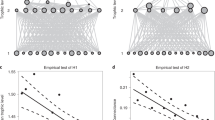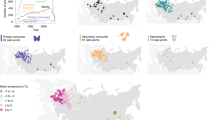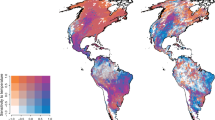Abstract
We know little about how ecosystems of different complexity will respond to global warming1,2,3,4,5. Microcosms permit experimental control over species composition and rates of environmental change. Here we show using microcosm experiments that extinction risk in warming environments depends on trophic position but remains unaffected by biodiversity. Warmed communities disproportionately lose top predators and herbivores, and become increasingly dominated by autotrophs and bacterivores. Changes in the relative distribution of organisms among trophically defined functional groups lead to differences in ecosystem function beyond those expected from temperature-dependent physiological rates. Diverse communities retain more species than depauperate ones, as predicted by the insurance hypothesis, which suggests that high biodiversity buffers against the effects of environmental variation because tolerant species are more likely to be found6,7. Studies of single trophic levels clearly show that warming can affect the distribution and abundance of species2,4,5, but complex responses generated in entire food webs greatly complicate inferences based on single functional groups.
This is a preview of subscription content, access via your institution
Access options
Subscribe to this journal
Receive 51 print issues and online access
$199.00 per year
only $3.90 per issue
Buy this article
- Purchase on Springer Link
- Instant access to full article PDF
Prices may be subject to local taxes which are calculated during checkout




Similar content being viewed by others
References
Frost,T. M., Carpenter,S. R., Ives,A. R. & Kratz,T. K. in Linking Species and Ecosystems (eds Jones, C. G. & Lawton, J. H.) 224–239 (Chapman & Hall, New York, 1995).
Davis,A. J., Jenkinson,L. S., Lawton,J. H., Shorrocks,B. & Wood,S. Making mistakes when predicting shifts in species range in response to global warming. Nature 391, 783–786 (1998).
Sanford,E. Regulation of keystone predation by small changes in ocean temperature. Science 283, 2095–2097 (1999).
Harte,J. & Shaw,R. Shifting dominance within a montane vegetation community: results of a climate-warming experiment. Science 267, 876–880 (1995).
Parmesan,C. et al. Poleward shifts in geographical ranges of butterfly species associated with regional warming. Nature 399, 579–583 (1999).
Naeem,S. & Li,S. Biodiversity enhances ecosystem reliability. Nature 390, 507–509 (1997).
Yachi,S. & Loreau,M. Biodiversity and ecosystem productivity in a fluctuating environment: the insurance hypothesis. Proc. Natl Acad. Sci. USA 96, 1463–1468 (1999).
Ives,A. R. & Gilchrist,G. in Biotic Interactions and Global Change (eds Kareiva, P. M., Kingsolver, J. G. & Huey, R. B.) 120–146 (Sinauer Associates Inc., Sunderland, 1993).
Houghton,J. T. et al. Climate Change 1995: The Science of Climate Change (Cambridge Univ. Press, Cambridge, 1996).
Lawton,J. H. Ecological experiments with model systems. Science 269, 328–331 (1995).
McGrady-Steed,J., Harris,P. M. & Morin,P. J. Biodiversity regulates ecosystem predictability. Nature 390, 162–165 (1997).
May,R. M. Stability and Complexity in Model Ecosystems (Princeton Univ. Press, Princeton, 1973).
Pimm,S. L. The Balance of Nature? (Univ. Chicago Press, Chicago, 1991).
Solé,R. V., Manrubia,S. C., Benton,M., Kauffman,S. & Bak,P. Criticality and scaling in evolutionary ecology. Trends. Ecol. Evol. 14, 156–160 (1999).
Bak,P. How Nature Works (Springer, New York, 1996).
Naeem,S. Species redundancy and ecosystem reliability. Cons. Biol. 12, 39–45 (1998).
Oksanen,L., Fretwell,S. D., Arruda,J. & Niemelä,P. Exploitation ecosystems in gradients of primary productivity. Am. Nat. 118, 240–261 (1981).
Kaunzinger,C. M. K. & Morin,P. J. Productivity controls food-chain properties in microbial communities. Nature 395, 495–497 (1998).
Naeem,S. & Li,S. Consumer species richness and autotrophic biomass. Ecology 79, 2603–2615 (1998).
Hector,A. The effect of diversity on productivity: detecting the role of species complementarity. Oikos 82, 597–599 (1998).
Loreau,M. Separating sampling and other effects in biodiversity experiments. Oikos 82, 600–602 (1998).
Hooper,D. U. The role of complementarity and competition in ecosystem responses to variation in plant diversity. Ecology 79, 704–719 (1998).
Tilman,D., Lehman,C. L. & Thomson,K. T. Plant diversity and ecosystem productivity: theoretical considerations. Proc. Natl Acad. Sci. USA 94, 1857–1861 (1997).
Schindler,D. E., Carpenter,S. R., Cole,J. J., Kitchell,J. F. & Pace,M. L. Influence of food web structure on carbon exchange between lakes and the atmosphere. Science 277, 248–251 (1997).
Pounds,J. A., Fogden,M. P. L. & Campbell,J. H. Biological response to climate change on a tropical mountain. Nature 398, 611–615 (1999).
Del Giorgio,P. A., Cole,J. J., Caraco,N. F. & Peters,R. H. Linking planktonic biomass and metabolism to net gas fluxes in northern temperature lakes. Ecology 80, 1422–1431 (1999).
McGrady-Steed,J. & Morin,P. J. Biodiversity, density compensation and the dynamics of populations and functional groups. Ecology (in the pre
Acknowledgements
We thank the NSF for supporting this research. Comments from the Morin lab, J. McGrady-Steed, S. Lawler, M. Loreau and S. Naeem improved the manuscript.
Author information
Authors and Affiliations
Corresponding author
Rights and permissions
About this article
Cite this article
Petchey, O., McPhearson, P., Casey, T. et al. Environmental warming alters food-web structure and ecosystem function. Nature 402, 69–72 (1999). https://doi.org/10.1038/47023
Received:
Accepted:
Issue Date:
DOI: https://doi.org/10.1038/47023
This article is cited by
-
Disruption of ecological networks in lakes by climate change and nutrient fluctuations
Nature Climate Change (2023)
-
Chronic exposure to environmental temperature attenuates the thermal sensitivity of salmonids
Nature Communications (2023)
-
Warming indirectly simplifies food webs through effects on apex predators
Nature Ecology & Evolution (2023)
-
Increased precipitation rather than warming increases ecosystem multifunctionality in an alpine meadow
Plant and Soil (2023)
-
Responses of three invasive alien aquatic plant species to climate warming and plant density
Journal of Plant Research (2023)
Comments
By submitting a comment you agree to abide by our Terms and Community Guidelines. If you find something abusive or that does not comply with our terms or guidelines please flag it as inappropriate.



